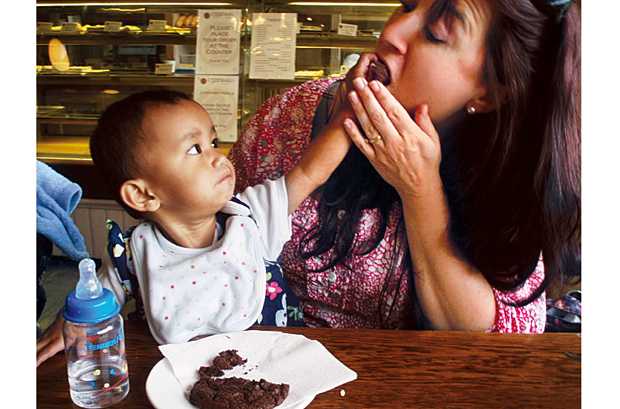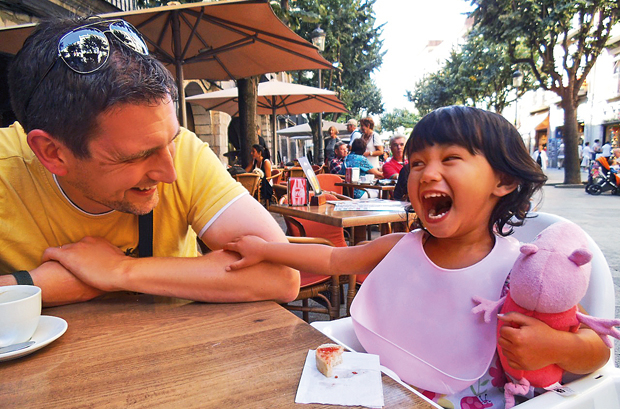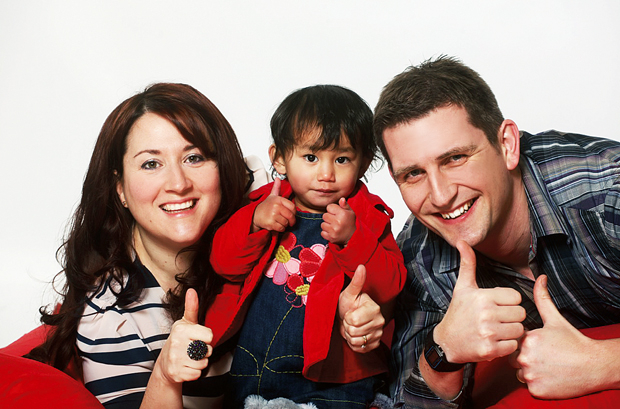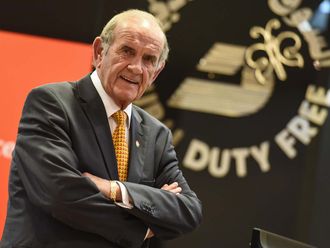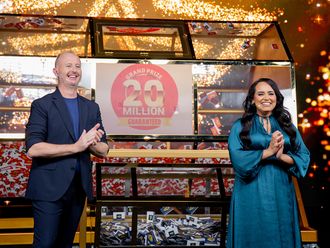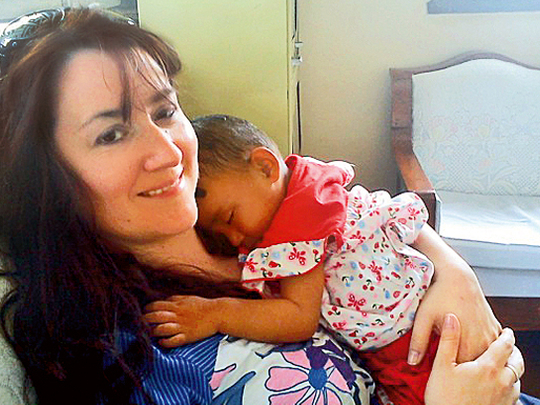
Trailing my fingers along the rack of pink romper suits in the Marks and Spencer babywear department, I felt a lump form in my throat. I knew I wouldn’t be able to hold it together. As I clutched one of the little outfits, tears welled up and I began to cry uncontrollably.
All I wanted, more than anything in the world, was a baby. And here I was, buying another gift for another friend who’d announced another pregnancy. It just didn’t seem fair.
For me, my life lacked purpose without a child and I had so much to give – but it just wasn’t happening.
My husband, Paul, and I had met at university when we were 18. I’d already been diagnosed with Polycystic Ovary Syndrome (PCOS), but back then the fact that I might not be able to have a baby hadn’t really been a concern – as far as I could see, PCOS meant I didn’t have regular periods like my friends, but that was about the extent of it. I didn’t fathom the implications of the diagnosis. It was only when Paul and I married when we were 23 that I began to think about how hard it might be for us to start a family.
“If we can’t have children, it doesn’t matter,’’ Paul used to say. He could have quite happily made life work without children, but for me, it just had to happen.
When we were 25, we started trying. After a year, I was put on a fertility drug called Clomifene. I could never have prepared myself for just how difficult it would be to have my hormones tampered with in such an intrusive way. The drug made me incredibly unhappy. I suffered from mood swings and took everything out on Paul.
He took my moods in his stride, but it wasn’t easy. It put our marriage under huge pressure. Every month I’d hope I was pregnant but time and again my hopes were raised then dashed.
It was emotionally exhausting and consumed my every waking moment. Every time the fertility clinic called and said the test was negative, I felt like a failure.
Most women trial Clomifene for six months. For two long years, we persevered.
Meanwhile, friends kept announcing pregnancies, including my best friend who one day called to say she was 10 weeks pregnant. I tried to congratulate her, but as I hung up the phone, I buried my head in Paul’s arms, crying away the pain. It wasn’t that I was jealous of my pregnant friends, but their pregnancies only served to highlight for me just what I was missing.
I felt broken. Everyone else was capable of getting pregnant, why not me?
It made me angry that I had to take all the drugs, mess with my hormones and my moods... I was depressed, life was no fun anymore.
After two years on the fertility drug, Paul called time on it. “It’s not working,” he told me gently.
Paul saved me from myself. I probably would have kept going forever, ignoring the terrible side effects. But I still wanted a baby more than anything.
We took a year off and I needed it. It was a year for us – no longer on the hamster wheel of fertility drugs and heart-breaking calls from the fertility clinic.
Then we felt ready to start discussing adoption. I’d spent many years travelling around developing countries and in my job as partnership adviser for a charity organisation, The Leprosy Mission, I knew how much children in poorer countries needed a chance. I realised it didn’t matter if my child was biologically mine or not – I would love an adopted child just as much.
I’d been to Nepal and loved it and we agreed that we wanted to adopt a girl from there.
For some families living in poverty in the Nepali culture, less value was placed on girls than boys. They were seen as an expense and were often abandoned. I read horror stories about baby girls being dumped in fields. Orphanages were overcrowded and often, older kids were put out on the streets to make room for babies.
So in 2004, we began the long and expensive process of finding our baby.
We needed close to £20,000 (around Dh120,000) – £5,000 each to be paid to the UK and Nepali governments, £1,000 for the baby’s visa, £3,000 to be paid to the orphanage as part of its fees and then the cost of tickets, stay in Nepal, and clothes and stuff for the baby. I will be eternally grateful to all the friends, family and complete strangers who helped us. We announced in our church that we were desperate for funds and within eight weeks, our community had raised £10,000. The rest of the money we pooled in from our savings.
For a year, a social worker visited us and ensured we were ready for what would be an invasive process. We were asked all about our family history and the strength of our marriage. After the difficult few years we’d had, Paul and I could have tackled anything; we were stronger than ever.
In our ignorance, we thought it would probably take about a year. After six months, the department of education signed off on our adoption request and we went out to buy a cot and baby clothes. Then Nepal announced it was closing international adoptions. It was expected to reopen eight months later, so we dutifully waited.
Two years of empty promises later, we didn’t know what to do. We were in limbo – we’d invested so much time and emotion in applying to adopt from Nepal, we felt it would be a step backwards to cancel our plans and pick a different country. We didn’t dare take time off work – Paul was a chief inspector at Lincolnshire police and I still worked at The Leprosy Mission – or spend any money on the house or make any plans because we never knew if they were about to call.
In 2007, we were told Nepal was reopening international adoptions and a year later, it did. I had friends in Nepal through work and they did so much to help – continuously badgering the government on our behalf and assuring us our case was being seen to. Although it was difficult being at the mercy of a foreign government, I was happier then than ever.
I was less jealous of my friends and I didn’t break down into tears every day – in my heart I knew that our time would come.
And then one day in December 2010, we were sent an email from my friend in Nepal who had been helping with our case. Attached was a photograph of a beautiful little baby girl called Marika. She was eight months old. “This will be your daughter!” the email read.
I burst into tears of happiness – finally I was going to be a mum. I was so excited I couldn’t do any work for the rest of the day, instead darting from desk to desk in my office showing anyone and everyone the picture.
I wanted to know everything I could about Marika. All the orphanage could tell us was that her mum had taken her to a hospital when she was just one day old and left her there. I saw that as evidence Marika’s mum did care about her; she took her to a hospital so she’d know she was safe. I felt we owed it to Marika’s birth mother to give her all the love we could. Now we just had to wait…Months dragged by, and finally in July 2011 we were suddenly told we had two weeks to come and meet Marika or the adoption would be cancelled.
Pandemonium ensued – we raced about buying car seats and things for the nursery, booked time off work and tried to guess what size baby clothes to buy.
And then, on July 6, 2011, we travelled to Lalitpur, Nepal.
Twelve years after we’d first started trying for a baby, we were about to meet our daughter. We were excited but terrified.
Were we crazy? What if she didn’t warm to us? What if we don’t bond? We had so many questions, so much anticipation. Marika was 16 months old then and as the carer carried her out, she clung to her, terrified by the very sight of us. Not only was our skin a different colour, we spoke a different language and Paul, at almost 1.9m, was far taller than the few men Marika had ever seen.
Marika was placed on my chest and eventually, she fell asleep. It was the greatest feeling in the world – Paul cried as he watched us.
On the second day, I sat with Marika as she tentatively rolled a ball towards Paul. He rolled it back. She smiled. Goosebumps raced up my arms – we were a family.
People had warned me, “Don’t worry if you don’t love her straight away.” But I loved Marika so much. From the moment I saw her, there was no hesitation, no fear. She was tiny, malnourished, suffering from worms and parasites, being fed on baby rice and teaspoons of water. All I wanted to do was protect her.
We spent the next few weeks together at a guest house within a hospital, so Marika could adjust to us before we took her home. She was wary and we needed her complete trust. On our sixth day, a volunteer at the hospital, who knew the lengths we’d gone to for this little baby girl, smiled as she watched Paul blow raspberries on Marika’s tummy, making Marika giggle. “It took you six years to adopt Marika,” she said, “but it only took Marika six days to adopt you.”
We stayed in Nepal for a month and in August flew home. Waiting for us were sacks-full of baby clothes from my friends whose daughters had long since grown out of them. They’d saved everything for me. As I sorted through the bags, I saw the very romper suits that I’d bought my friends’ babies all those years ago.
My friends had never given up hope. It took me back to my meltdown in Marks and Spencer, all the pain and desperation. I wished that I had known then that one day, my own little girl would be wearing those clothes. It’s hard for me to think back to that sadness now. Marika has healed all that pain – I hardly remember what life was like before she came along.
Motherhood is tiring and hard work and wonderful and all the things I hoped it would be. Paul is besotted by our daughter – he takes her swimming and when I watch them leave the house hand in hand, I feel so fulfilled.
Marika was in a sorry state when we found her. But I watch her now, a healthy, bubbly three-year-old who never stops chattering, loves her friends, her ballet, her toys, and I can’t believe it is the same little girl.
We know it’s important to keep Marika’s heritage alive – we have a big map of Nepal in her room and our Nepali friends visit often. She’s too young for questions now, but we always will be open about where she came from. One day, I’ll take Marika back to Nepal. I want her to be proud of her roots.
Paul and I are preparing to adopt another child – a boy – to complete our family. People say when you adopt, the baby doesn’t grow in your womb, it grows in your heart. My journey to motherhood took me to the brink and back, but Marika is worth every tear and every penny.
Louise Timmins, 38, lives with Paul and Marika in Lincolnshire, UK


